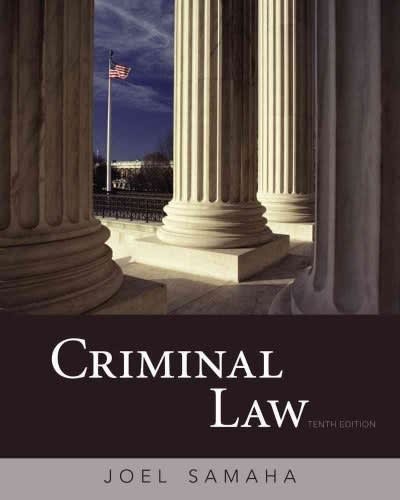Gary Ewing was convicted in a California trial court of felony grand theft and sentenced to 25
Question:
Gary Ewing was convicted in a California trial court of felony grand theft and sentenced to 25 years to life under that state’s three-strikes law. The California Court of Appeal, Second Appellate District, affirmed the sentence, and the State Supreme Court denied review. Certiorari was granted. The Supreme Court held that the sentence did not violate the Eighth Amendment’s prohibition against cruel and unusual punishment.
O’CONNOR, J., joined by REHNQUIST, CJ., and SCALIA, KENNEDY, and THOMAS, JJ.
On parole from a nine-year prison term, petitioner Gary Ewing walked into the pro shop of the El Segundo Golf Course, in Los Angeles County, on March 12, 2000. He walked out with three golf clubs, priced at $399 apiece, concealed in his pants leg. A shop employee, whose suspicions were aroused when he observed Ewing limp out of the pro shop, telephoned the police. The police apprehended Ewing in the parking lot.
Ewing is no stranger to the criminal justice system. In 1984, at the age of 22, he pleaded guilty to theft. The court sentenced him to six months in jail (suspended), three years’ probation, and a $300 fine. In 1988, he was convicted of felony grand theft auto and sentenced to one year in jail and three years’ probation. After Ewing completed probation, however, the sentencing court reduced the crime to a misdemeanor, permitted Ewing to withdraw his guilty plea, and dismissed the case.
In 1990, he was convicted of petty theft with a prior and sentenced to 60 days in the county jail and three years’ probation. In 1992, Ewing was convicted of battery and sentenced to 30 days in the county jail and two years’ summary probation. One month later, he was convicted of theft and sentenced to ten days in the county jail and 12 months’ probation. In January 1993, Ewing was convicted of burglary and sentenced to 60 days in the county jail and one year’s summary probation. In February 1993, he was convicted of possessing drug paraphernalia and sentenced to six months in the county jail and three years’ probation. In July 1993, he was convicted of appropriating lost property and sentenced to ten days in the county jail and two years’ summary probation. In September 1993, he was convicted of unlawfully possessing a firearm and trespassing and sentenced to 30 days in the county jail and one year’s probation.
In October and November 1993, Ewing committed three burglaries and one robbery at a Long Beach, California, apartment complex over a five-week period. He awakened one of his victims, asleep on her living room sofa, as he tried to disconnect her video cassette recorder from the television in that room. When she screamed, Ewing ran out the front door. On another occasion, Ewing accosted a victim in the mailroom of the apartment complex. Ewing claimed to have a gun and ordered the victim to hand over his wallet. When the victim resisted, Ewing produced a knife and forced the victim back to the apartment itself. While Ewing rifled through the bedroom, the victim fled the apartment screaming for help. Ewing absconded with the victim’s money and credit cards.
QUESTIONS
1. List Gary Ewing’s crimes, and match them to the three-strikes law.
2. Define “proportionality” as the plurality opinion defines it. Summarize how the majority applies proportionality to Ewing’s sentence. How does Justice Scalia define “proportionality,” and how does his application of it to the facts differ from the majority’s? Summarize how the dissent applies the principle of proportionality to the facts of the case.
3. In your opinion, was Ewing’s punishment proportional to the crime? Back up your answer with the facts of the case and the arguments in the opinions.
4. If Justice Thomas is right that the Eighth Amendment contains no proportionality principle, what is cruel and unusual punishment?
Step by Step Answer:






